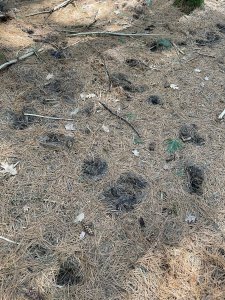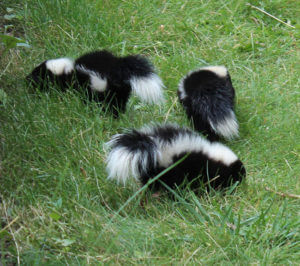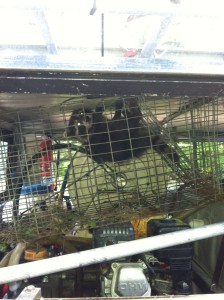Many homeowners spend painstakingly long hours perfecting their lawn and landscaping. To much shock, they may wake up one morning to find the property in disarray— the ground having been clearly dug into in multiple spots. Just what caused all of this damage? The culprit you may not expect, skunks!
example of skunk damage in woods
Why Skunks Dig in the Ground
Skunks typically dig in search of food or shelter. Where there are huge chunks of grass that seem to be pulled right out of the earth, the skunks have likely been harvesting grubs that lie beneath the surface. They pull the grass to get to grubs found just below the first layer of soil. A single skunk can cause significant property damage, but an entire family of skunks ransacking for grubs can rack up quite the landscaping bill.
Other Issues
Skunks damage lawns and damage the home, trying to find a place to burrow. Obviously, they are most notorious for spraying household pets, but skunks can also carry diseases and bite if trapped. This is especially true if their first defense mechanism, spraying, don’t allow them to escape. Bites and droppings in the yard can cause diseases, which can then spread to your family.
How to Tell if Skunks are the Culprit
It’s important to note that skunks aren’t the only culprits of lawn damage, so how can you tell if they are the problem? Spotting a skunk would obviously tell you this, but if the homeowner doesn’t see the skunk in their yard, they must look for other tell-tale signs. The stench of nearby skunk spray would fall under this category. But what if you’re 0/2 for skunk signs? If there are visible tracks, comparing them to skunk tracks can help you properly identify them. Your best bet is to contact a licensed pest control specialist for proper identification and trapping.
Removing Skunks from the Yard
Those who have had their property damaged by skunks will likely want to know how to prevent it from happening again. One of the most sure-fire ways to deter skunks is by using light. Skunks are nocturnal, so a motion-activated floodlight may work to scare them away. Spraying predator urine around the property is also said to discourage skunks from the area. However, even the most valiant of DIY eradication efforts often come up shorthanded. Calling a professional is most often the last resort when it really should be first. Trapping or coming into physical contact with the skunk must be done by a professional. This ensures they are properly taken care of. In terms of relocation, it must be done by a professional as well. In some states, it is illegal for a homeowner to trap and release wildlife on their own.
Keep Skunks Out of the Yard
Once the skunks have been eradicated, the homeowner may want to take preventative measures to ensure the skunks will not return and further damage their property. The most effective way to do this is by making sure the yard is correctly cared for so you won’t find any grubs under the grass. Another way is to consider fencing off parts or all of the yard. This has the benefit of keeping all sorts of other animals off of the property as well.
Despite how much time and care you put into your lawn and landscaping, skunks can (and will) wreck it if grubs are available. They’ll often return and bring friends. If you’ve noticed damage to your lawn and you suspect it is because of skunks, contact Hogarth’s Pest Control & Wildlife Removal to help you solve this issue once and for all.


